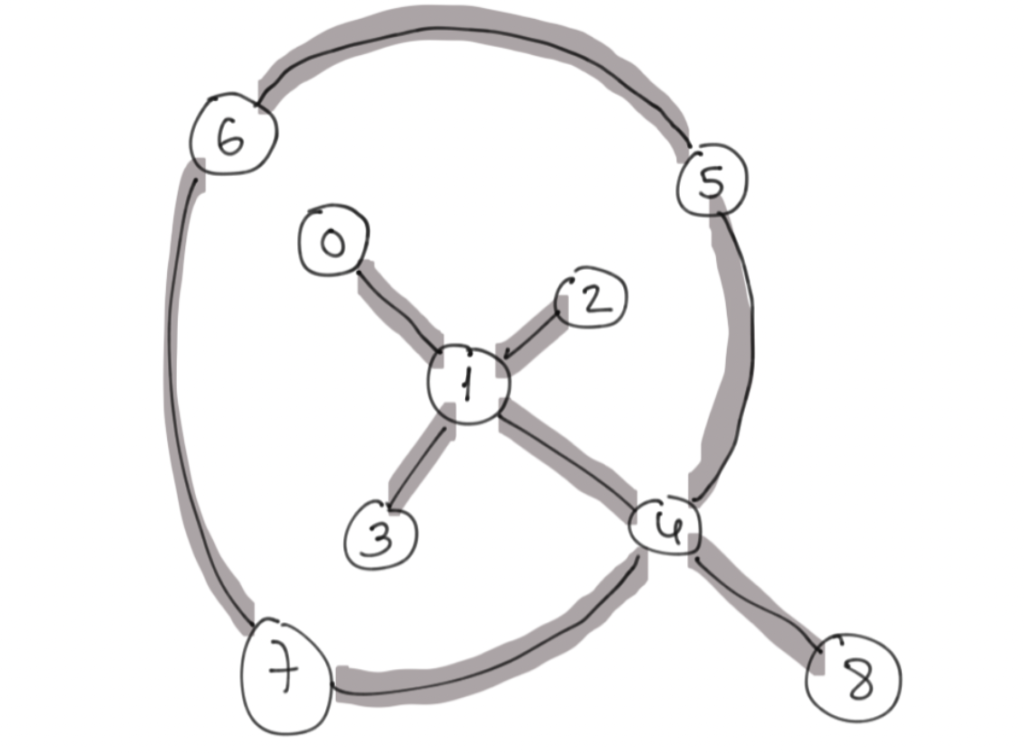I continued on the Algorithm track with the adapting topologies exercise. It is an easy, but very enjoyable task, I just really like working with graphs.
Topology
Quanta need to be next to each other, when performing multi-qubit operations like CNOT, SWAP, etc. on them. If you want to perform a multi-qubit operation on non-adjacent qubits, you’ve got to SWAP them around, until they are next to each other. Therefore, a higher connectivity is beneficial to save up coherence for the main calculations.
However, operations on qubits may cause cross-talk on neighboring qubits, and therefore reducing coherence.
Now the topology of a QPU has to weigh-in both effects, and there are topologies that optimize for reduced cross-talk (e.g. ion traps), maximal connectivity, or seek to balance the two (e.g. IBM’s heavy hexagonal lattice).
Exercise
Now in this exercise, a toy topology is provided, and the challenge is to calculate the number of SWAPs required to perform a CNOT gate. For this, I used the python library networkx.

import networkx as nx
def get_topology_graph():
"""Create an adjacency graph, of the topology dict.
Args:
Returns:
- (nx.Graph): adjacency graph
"""
G = nx.Graph()
for i, nodes in graph.items():
elist = [(i, j) for j in nodes]
G.add_edges_from(elist)
return GThe SWAP count, is then easily calculated from the length of the shortest path (don’t forget to rewind the operations, to clean up after the CNOT).
def n_swaps(cnot):
"""Count the minimum number of swaps needed to create the equivalent CNOT.
Args:
- cnot (qml.Operation): A CNOT gate that needs to be implemented on the hardware
You can find out the wires on which an operator works by asking for the 'wires' attribute: 'cnot.wires'
Returns:
- (int): minimum number of swaps
"""
G = get_topology_graph()
wires = cnot.wires
path = nx.shortest_path(G, wires[0], wires[1])
return 2*(len(path)-2)The results check out, success!
Plotting a sample circuit
To round the story up, I wrote a small routine to build out a circuit, that actually swaps the qubits around ..
dev = qml.device("default.qubit", wires=len(graph))
@qml.qnode(dev)
def n_swaps_perf(wire1, wire2):
G = get_topology_graph()
path = nx.shortest_path(G, wire1, wire2)
path.pop(-1) # remove last item, to have easier indexing in loops
for i in range(1, len(path)):
qml.SWAP(wires=[path[i], path[i-1]])
qml.CNOT(wires=[path[-1], wire2])
rev_path = list(reversed(path))
for i in range(1, len(rev_path)):
qml.SWAP(wires=[rev_path[i], rev_path[i-1]])
return qml.expval(qml.PauliZ(wires=wire2)).. and plots the resulting circuit.
drawer = qml.draw(n_swaps_perf)
print(drawer(8,2))1: ───────╭SWAP─╭●─╭SWAP───────┤ 2: ───────│────╰X─│───────────┤ <Z> 4: ─╭SWAP─-╰SWAP────╰SWAP─╭SWAP─-┤ 8: ─╰SWAP────────────────╰SWAP─┤
Looks good.